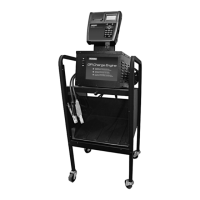5:/057
0LWL,06WWL,
LWL
KDSWHULDRVWLFKDUL
Step 2: The Battery Diagnostic Station measures the battery’s
CCA (approximately 8 seconds)
5HFRYHU0RGH
Under certain conditions the charger will switch from
Automatic Charge to Recovery Mode to fully charge the
battery. The maximum charge time of a Recovery Mode cycle
is 30 minutes, although most batteries will nish charging
sooner. During Recovery Mode the charger continuously
analyzes the battery to make a decision as quickly as possible.
$ERUWLDKDUH6HVVLR
If you need to abort the charging session, press the
32:(5
key. You will not be able to obtain a test code for a possible
REPLACE decision for an uncompleted charge. After aborting,
select NEXT to return to the Main Menu.
7RWDO
FKDUL
WLPH
$PSKRXUV
UHSODFHG
KDUL
PRGH
RPSOHWLDKDUH6HVVLR
The charge session is complete when the proper amount of
charge is put back into the battery or the remaining estimated
time to charge counts down to near zero.
If the Battery Diagnostic Station nds that the battery is bad
before the end of the estimated time to charge, it displays the
decision REPLACE BATTERY or REPLACE-BAD CELL and the
results. Both decisions include a test code.
LDRVWLFKDUH5HVXOWV
The Battery Diagnostic Station displays one of four battery
decisions (GOOD BATTERY, REPLACE BATTERY, BAD CELL-
REPLACE, and MARGINAL) and an analysis, which includes the
battery State-of-Health (SOH). Refer to the screen illustrations
and the table on pages 30 and 31.
Use the UP or DOWN ARROW keys to scroll to each screen. To
return to the Main Menu, press the EXIT soft key. To print, press
the PRINT soft key.
IMPORTANT: When you start a new test, the last battery test
in memory will be overwritten. Remember to record or
print the results if you need to retain them.
6WDWHRIHDOWK62
A factor that aects a battery’s ability to crank an engine is its
actual condition or State-of-Health (SOH). It is a measure of the
battery’s condition relative to a fresh battery. Based on cranking
rating, open-circuit voltage, conductance (ability to deliver
current) and battery temperature, the Battery Diagnostic Station
will not only qualify a battery as “good” or “bad” (should be
replaced), but can also identify a “marginal” battery.
Although a State-of-Health problem can be the result of
defects in construction, it is most often the result of normal
wear-out mechanisms, which are dependant on vehicle needs,
climate, and operating conditions. This results in irreversible
physical and chemical changes until eventually the battery
can no longer hold a charge and supply the power necessary
to start the car and provide auxiliary power to the electrical
system.
As the battery approaches end of life, its deterioration
accelerates, until it nally fails to start the vehicle. Before
failing, the battery may start the vehicle under normal
conditions but may not be able to operate in more extreme
conditions. Extreme heat or cold could expose a weak battery
and cause it to fail.
//53/5HVOWVlDRVWlFKDUH0RGH
UHH
0HDVXUHG
YROWDH
0HDVXUHG
FDSDFLW
6HOHFWHG
UDWL
7RWDO
FKDUL
WLPH
%DWWHU
GHFLVLR
5HSODFHG
DPSKRXUV
UHH
5HWXU$X
WKRULDWLR
RGH
IRU5(3/$(
GHFLVLRV
UHH
7KHDUHDR
WKHOHIWRIWKH
GLDOLGLFDWHV
D5(3/$(
GHFLVLR
7KHDUHD
RWKHULKW
LGLFDWHV
D*22
EDWWHU
7KHDUHDL
WKHFHWHU
RIWKHGLDO
LGLFDWHV
DPDULDO
EDWWHU

